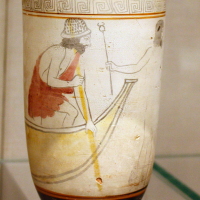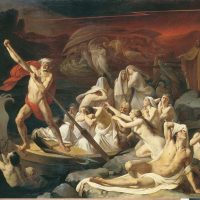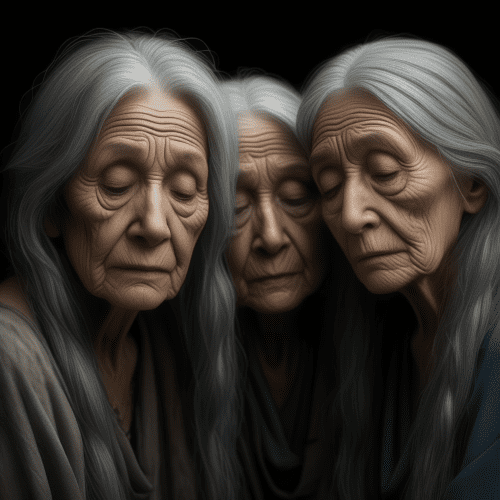Charon : The Greek Ferryman
Listen
At a glance
| Description | |
|---|---|
| Origin | Greek Mythology |
| Classification | Spirits |
| Family Members | Nyx (Mother), Erebus ((Father) |
| Region | Greece |
| Associated With | Travel to underworld |
Charon
Introduction
Charon is one of the most haunting figures in Greek mythology, forever tied to the imagery of death and the passage into the underworld. Unlike the Olympian gods who embody power, light, or dominion over the natural world, Charon’s role is far more somber yet essential: he ferries the souls of the deceased across the rivers that separate the world of the living from Hades’ realm. Most commonly associated with the Styx and Acheron, these crossings symbolized the inescapable journey of mortality. His presence in myth shaped funeral rituals, influenced artistic depictions of death, and cemented his place as a figure both feared and respected.
Physical Traits
Ancient portrayals of Charon emphasize his intimidating presence. Greek vase paintings and sculptures often show him as a wiry, weather-beaten old man with a ragged beard, sharp features, and eyes that seem to pierce through the living and the dead alike. He usually wears a coarse tunic and sometimes a conical hat, standing beside his narrow skiff with an oar or pole ready to guide souls across the dark waters.
While Greek depictions present him as stern and human-like, his Etruscan counterpart Charun was far more monstrous, with blue-grey skin, tusks, hooked nose, and serpents coiled around his arms. This striking difference shows how neighboring cultures reimagined the ferryman—Greeks made him grim yet dignified, while the Etruscans turned him into a nightmarish figure of brute death. Both versions underline the same truth: Charon’s presence embodies the inevitability of mortality and the crossing into the afterlife.
Family
Charon’s genealogy is only faintly outlined in Greek sources. The most widely accepted version identifies him as the son of Nyx, the goddess of Night, and Erebus, the god of Darkness. This lineage is fitting, as his character is steeped in shadows, boundaries, and the obscurity of death. Unlike the Olympians, who interact with mortals through blessings or punishments, Charon’s duty is unchanging and absolute, with no room for emotion or deviation.
Though he is not a ruler like Hades, he works in concert with him and with Hermes Psychopompos, the divine guide who escorts the newly dead to the riverbank. Together, they form part of the Greek vision of the afterlife: Hermes leads the way, Charon provides passage, and Hades oversees the final destination. This structure reflects how death itself was viewed—not as chaos, but as an ordered transition governed by strict roles.
Other Names
The name Charon comes from the Greek Kharōn (Χάρων), linked to the word charopós, meaning “of keen gaze” or “fierce-eyed.” This etymology highlights the piercing stare often attributed to him in art and literature. Unlike the benevolent Hermes or the stern but regal Hades, Charon’s very name connects him to the sharp, almost fiery eyes that mark him as vigilant and uncompromising.
In Etruscan belief, he was known as Charun, and while his name is similar, the imagery diverges sharply toward a more brutal and terrifying figure. In later Greek folklore, particularly in Byzantine and modern traditions, Charon evolved into Charos or Charontas, a personification of death akin to the Angel of Death in Christian tradition. These continuations prove that his myth outlasted antiquity, adapting to different cultural and religious contexts while retaining his association with mortality.
Powers and Abilities
Charon’s authority rests in his exclusive role as ferryman of souls. Only he has the power to cross the dark rivers that separate the mortal world from the underworld, and only those who paid the fare could board his skiff. Burial customs in Greece reflected this myth, as families placed a coin—often an obol or danake—inside the mouth of the deceased. Without it, the soul was doomed to wander the banks of the Styx for a hundred years before being granted passage.
Though stern, his power was not limitless. Myths tell of rare occasions when living heroes entered his boat: Heracles, Theseus, Orpheus, and Aeneas all persuaded or compelled Charon to allow them entry to Hades. In some stories, he was punished by Hades for permitting mortals to pass, underscoring how tightly controlled the laws of death were. The Etruscan Charun expanded on this idea by wielding a massive mallet, a weapon used to drive souls onward or strike down the condemned, which made him more actively violent than his Greek counterpart.
Charon himself was not a judge of souls—he did not decide who was saved or damned. Instead, his strength lay in being incorruptible, a figure who carried out the cosmic law of passage with neither pity nor malice.
Modern Day Influences
Charon’s shadow stretches far beyond antiquity. In literature, Dante Alighieri immortalized him in the Inferno, where the ferryman guides the damned across the river Acheron with “eyes of fire.” Artists from Gustave Doré to Michelangelo have drawn upon Charon’s imagery, blending the ferryman with the medieval Grim Reaper to create a universal figure of death.
Science has also carried his name into the cosmos. In 1978, astronomers named Pluto’s largest moon Charon, a fitting tribute given Pluto is the Roman equivalent of Hades. The moon’s orbit around its dark parent body mirrors the eternal service of the ferryman circling death. In paleontology, the dinosaur Charonosaurus was named to reflect its discovery by a river, evoking the mythological crossing.
In popular culture, Charon appears in countless works. From the epic poem Aeneid to modern novels, films, and video games like God of War and Hades, he remains a staple character, reimagined in ways that keep his mystery alive. His image persists in fantasy as the archetype of the underworld guide, reminding audiences of the thin line between life and death. Even in psychology and philosophy, Charon has been used as a metaphor for transition, the unknown, and the acceptance of mortality.
Related Images
Source
Britannica. (2025, September 3). Charon | Myth & Symbols. Encyclopaedia Britannica. https://www.britannica.com/topic/Charon-Greek-mythology
Wikipedia. (2022, September 1). Charon. https://en.wikipedia.org/wiki/Charon
Theoi Greek Mythology. (n.d.). CHIRON (Kharon) – Ferryman of the Dead, Underworld Daimon. https://www.theoi.com/Khthonios/Kharon.html
Centre of Excellence. (2024, September 19). Who was Charon in Greek Mythology? Powers, Symbols & Influences. https://www.centreofexcellence.com/charon-of-greek-mythology/
Simple English Wikipedia. (2006, June 14). Charon (mythology). https://simple.wikipedia.org/wiki/Charon_(mythology)[6]
Study.com. (n.d.). Charon, the Ferryman | Myth, Role & Later Interpretations. https://study.com/academy/lesson/charon-ferryman-hades-myths-symbols.html
Lewis, J. R. (2003). The Astrology Book: The Encyclopedia of Heavenly Influences. Visible Ink Press.
Fandom. (2025, June 9). Charon – Hades Wiki. https://hades.fandom.com/wiki/Charon
Graves, R. (1955). The Greek Myths. Penguin Books.
Hamilton, E. (1942). Mythology: Timeless Tales of Gods and Heroes. Little, Brown and Company.
Morford, M., Lenardon, R. J., & Sham, M. (2018). Classical Mythology (11th ed.). Oxford University Press.
Burkert, W. (1985). Greek Religion: Archaic and Classical. Harvard University Press.
Boccaccio, G. (1370). Genealogia Deorum Gentilium. Translated edition consulted via academic archive.
Frequently Asked Questions
What is lorem Ipsum?
I am text block. Click edit button to change this text. Lorem ipsum dolor sit amet, consectetur adipiscing elit. Ut elit tellus, luctus nec ullamcorper mattis, pulvinar dapibus leo.
What is lorem Ipsum?
I am text block. Click edit button to change this text. Lorem ipsum dolor sit amet, consectetur adipiscing elit. Ut elit tellus, luctus nec ullamcorper mattis, pulvinar dapibus leo.
What is lorem Ipsum?
I am text block. Click edit button to change this text. Lorem ipsum dolor sit amet, consectetur adipiscing elit. Ut elit tellus, luctus nec ullamcorper mattis, pulvinar dapibus leo.
What is lorem Ipsum?
I am text block. Click edit button to change this text. Lorem ipsum dolor sit amet, consectetur adipiscing elit. Ut elit tellus, luctus nec ullamcorper mattis, pulvinar dapibus leo.
What is lorem Ipsum?
I am text block. Click edit button to change this text. Lorem ipsum dolor sit amet, consectetur adipiscing elit. Ut elit tellus, luctus nec ullamcorper mattis, pulvinar dapibus leo.














